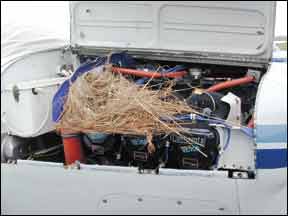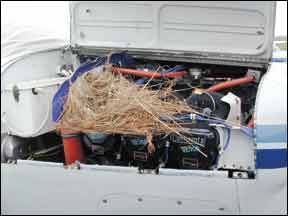Kick the tires, light the fires.” So goes a popular, flippant saying about preflight inspections. Most of the time, thats what we and various accident reports would label an “inadequate preflight inspection.” Sometimes-immediately after stopping long enough to drop off or load a passenger, for example-it might be adequate. After all, we just flew it in here-its a perfectly good airplane; why bother risking burnt fingers to check the engine oil or soiling our clothes to check tire pressure? 288 Indeed, we dont go to such trouble when getting in a car; why are we conducting an inspection at all? Thats easy: Because despite the overall safety of general aviation, regardless of our comfort with flying and/or with the specific airplane, the hard truth is that airplanes are terribly unforgiving of mechanical imperfection. The chance of an engine failure, partially blocked control travel, errant birds nest or a structural issue is very slight, but the consequences of any of these can be heartlessly severe. My first flight instructor taught me to take the time to thoroughly inspect an airplane because, “The airplane is trying to kill you; its up to you to catch it in time.” Thats the attitude with which we need to inspect our airplanes. We Missed What? A student pilot and instructor had just completed a night training flight and were tying down the rented Beech Musketeer. Securing the aircraft, one of the pilots noticed a long stripe on the bottom of one wing-paint, and not a color associated with that aircraft. There was no evident damage, but the foreign paint was a troubling mystery. Later investigation revealed the yellow paint color identically matched a short, upright obstruction alongside the ramp, but farther down the line and away from the path the night-flight crew had used to exit and return to the tiedown area. The squawk was at least one flight removed from this student and CFI…and whoever taxied or pulled the Musketeer over the pole had either not noticed his/her error, or knew it happened but did not squawk the airplane and ground it pending a mechanics inspection. What was especially troubling, however, was that the crew who found the mis-matched paint had preflighted the airplane (in the dark, but using a flashlight), but did not notice the now-obvious “occult” paint before taking off. There was no damage to the airplanes wing, but there could easily have been, damage they might not have noticed before attempting to take off. Im as guilty as the next guy when it comes to sometimes wanting to rush a preflight. No, I was neither student nor instructor in this case (or the flight before). But there have been several times when I have had to stop myself, take a deep breath, and slow down to make a real inspection of an airplane before launch. Would the night-crew have canceled its flight until a mechanic was available to inspect the wing in the light of day if they had seen the paint stripe during preflight? We dont know, but it could have gone either way. Instead, we need to fight the temptation to accept a broken airplane because an emotional or schedule-related “need” to fly. Unless youre on a combat mission or, as that same colorful instructor told me, “someone is shooting at you,” no one needs to fly on any given day (or night). There for a Reason The purpose of a preflight inspection is not only to see that everything is attached to the airframe, but also that everything works. Testing the proper function of indicating and warning systems before taking off is one of many things we should be doing if we want them to be available to protect us. It may have saved these lives in a Cessna 172. The purpose of the flight was to conduct aerial surveys of bird activity. At about 300 feet agl, a witness observed the nose of the airplane drop. The airplane then banked to the right with an accompanying increase in engine noise, and descended into the ground. The airplane had flown approximately 1.5 hours since being fueled on the morning of the accident. The airplane was five pounds over maximum gross weight based on the measured weight of the contents. Fuel was observed surrounding the accident site, and as such, the airplanes actual gross weight was considered higher than the measured value. Impact damage was consistent with a stall/spin and subsequent collision with terrain. Post-accident examination revealed the stall warning device was inoperative at the time of the accident. Two pilots who had previously flown the bird-surveying missions reported they were instructed by the research leader to fly the airplane at altitudes between 200 and 500 feet agl. They further reported the type of maneuvers and low airspeeds required to perform the missions would often cause the stall warning horn to sound. Aside from the stall warning horn, no other pre-impact mechanical malfunctions were identified with the accident airplane. The NTSB determined the probable cause of this accident as, “The pilots failure to maintain an adequate airspeed while maneuvering at low altitude. Contributing to the accident was the overweight condition of the airplane and the inoperative stall warning horn.” In a Rush A proper preflight takes time and requires we complete every step completely. If outside pressure entices us to rush the preflight, its much more likely we wont catch something vital, as the pilots of an American Legend Cub learned: The airplane was ditched in Lake Michigan following a total loss of engine power due to fuel exhaustion. The private pilot on board drowned following the ditching. He just purchased the airplane and was relocating it to an airport near his home when the accident occurred. The pilot did not have a tailwheel sign-off or a current flight review. Arrangements were made through the aircraft manufacturer for an airline transport pilot/certified flight instructor who was a test and demonstration pilot for the company to fly the airplane to Ohio with the new owner. Prior to takeoff, there was an aircraft accident involving another airplane, and the airport was temporarily closed. During this delay, the ATP/CFI stepped up on the right wing step and looked over the wing trying to see the accident. He stated that when he got down off the wing the private pilot got up on the right wing step to look. The ATP/CFI stated that while the private pilot was up on the wing step, they were informed the first four airplanes to get to the engine start line would be able to depart. He stated that with the assistance of other pilots, they were second at the start line and were able to take off. The ATP/CFI stated that when up on the wing step, the only handhold available was the fuel cap, which both he and the private pilot held onto. The ATP/CFI stated the private pilot flew the airplane over the shoreline and out over the lake. He stated he commented to the private pilot about how far out over the water they were and after several comments the private pilot “reluctantly turned back closer to the shore line.” The ATP/CFI stated that after flying for approximately two hours, he noticed the left fuel tank quantity indicator was indicating that the fuel tank was empty and the right fuel tank quantity indicator was showing about one inch of fuel. He stated the private pilot stated that the “fuel gauges must be malfunctioning as the EIS [electronic information system] indicated that the rate of fuel burn was 5.8 gph, with 8.3 gallons of fuel remaining.” He stated the private pilot also told him the EIS indicated there was one hour and 20 minutes of flying time remaining. He stated the private pilot then decided to divert to a closer airport. Approximately 20 minutes later, he noticed that both fuel gauges were indicating empty. He stated that the private pilot again reported the EIS was showing a fuel flow of 5.8 G.P.H. with 6.1 gallons of fuel left. The ATP/CFI stated that approximately four minutes later, the engine lost power. The private pilot landed the airplane on the water. Both pilots exited the airplane unharmed, however, the private pilot, who did not know how to swim, subsequently drowned. The ATP/CFI was picked up by a Coast Guard Auxiliary boat approximately 40 minutes after the accident. The right fuel cap was missing from the airplane when it was recovered from the bottom of the lake. No mechanical failures/malfunctions were noted during the on-scene examination of the airplane and engine. The NTSB determined the accidents probable cause to be, “The failure of both pilots to assure that the fuel cap was securely in place prior to takeoff, which resulted in fuel siphoning and ultimately fuel exhaustion. An additional cause was the decision to fly over the lake outside of gliding distance to shore along with the delay in diverting to refuel the airplane.” As an aside, recall that electronic fuel monitoring systems are only as accurate as the fuel load data you input before engine start, and only measure the amount of fuel that goes through the fuel lines to the engine. It does not account for any fuel lost past the fuel cap, through vent lines or by any other leaks. Always trust a fuel sight gauge over any other indicating system, and float-type fuel indicators over electronic means if the float-type gauges indicate less than expected. A Lot of Responsibility The FARs make the pilot-in-command ultimately responsible for determining the airworthiness of the aircraft. Thats a whole lot of responsibility. You might argue mechanics should be held accountable for the maintenance state of the aircraft, but when it comes down to it, pilots are the ones putting our trusting passengers at risk, and will personally suffer if the airplane is not ready to fly. Reference this fatal mishap: While climbing after takeoff, the former Czech military jet trainer experienced a total loss of engine power and struck pine trees in a wooded area about one mile southwest of the airport. Subsequent examination of the airplanes fuel system revealed fuel that drained from the fuel filter was contaminated with black sediment, and appeared “extremely cloudy.” Additionally, the fuel filter element was contaminated and restricted the flow of fuel to the engine. The pilot purchased the airplane about one year prior to the accident. The maintenance records were not located. The pilot fueled the airplane from a tank on the back of a pickup truck. Review of fuel receipts revealed that the day prior to the accident, the pilot purchased about 138 gallons of “kerosene,” six gallons of “off-road diesel,” and 27 gallons of “diesel” fuel. Review of a preflight inspection checklist for the airplane revealed it included discharging two liters of fuel from the fuel filter drain to check for contamination. The NTSBs probable cause statement: “A total loss of engine power due to fuel starvation as a result of a clogged fuel filter that was not identified due to the pilots inadequate preflight inspection.” Living Up To The Challenge We inspect airplanes at the worst possible time, when were ready to fly. Our thoughts can easily drift to the flight itself, to explaining about airplanes to a new passenger, or to discussing the upcoming session with a student. Its dangerously easy to rationalize away a squawk found when youre wanting to go fly. But necessity dictates we preflight, well, our preflight. We need to focus on what were inspecting, use a checklist to ensure we miss nothing and dispassionately determine if the airplane needs any correction or repair, if we are to expect the airplane to live up to the mechanical challenge of flight. Tom Turner is a CFII-MEI who frequently writes and lectures on aviation safety.




